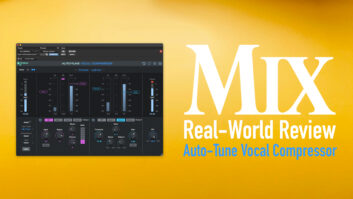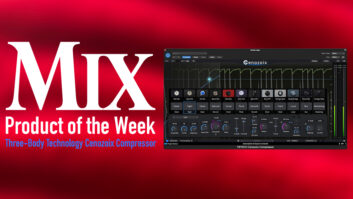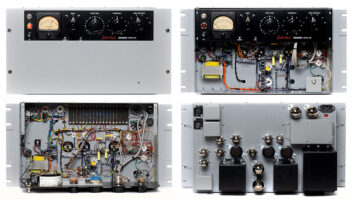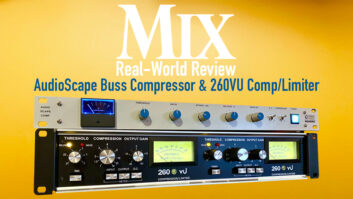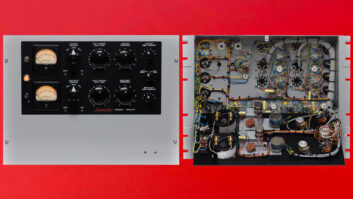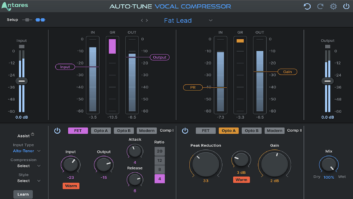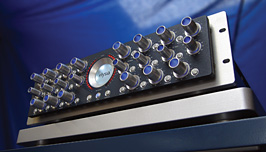
To treat the wide variety of material thrown at them, many mastering engineers have multiple compressors and limiters at their disposal. German manufacturer elysia has a better solution: Make a box that covers (almost) all the bases. The company’s 2-channel alpha compressor offers switchable feedback and feed-forward gain-control circuit paths, adjustable low- and highpass sidechain filters, parallel processing, stereo and M/S (Mid/Side) operational modes, channel linking, defeatable transformer-based coloration, a soft-clipper and audio path filter, and more. Billed as a mastering compressor, the alpha can, of course, also be used as a dual-mono or stereo dynamics processor for tracking or mixing applications.
IF LOOKS COULD KILL
A colleague of mine once jokingly declared that the most important feature of any studio is its “lights.” The alpha won’t disappoint here. When the unit is powered up, each rotary control’s indicator mark and center post are constantly lit up like a Christmas tree with neon-blue LEDs.
Each push-button switch, with one exception, lights an inset white LED when activated. (The Active button, which serves both channels, lights a blue LED.) Mirror-image, half-moon-shaped LED ladders for each channel (sporting 16 segments each) light red to show gain-reduction amounts. Soft-clipper action is indicated by gold-colored LEDs. Global LED dimmers are also provided for the visually timid. The unit’s overall visual effect is absolutely stunning.
CONTROL FREAKS REJOICE
Immediately below alpha’s LED ladders are buttons that bypass processing (for both channels at once), switch between stereo and M/S modes, and link or unlink channels (left and right in stereo mode, or mid- and side in M/S mode).
All other controls are identical for each channel and are logically arranged in three rows. Each rotary control offers 21 detented settings to allow repeatability. The top row of controls includes those for adjusting threshold, attack, release and ratio, with the last three giving the lower values the most attention. Also in this top row are three push-button switches. One button toggles between feed-forward (harder-sounding) and feedback (more transparent) compression schemes. An Auto-Fast attack button speeds up attack time to reduce transients when engaged. Activating an Auto-Fast release button speeds up recovery from deep compression at the onset of the two-stage release curve it initiates.
The alpha’s second row of controls activates and shapes separate filters for the audio path and internal sidechain. The sidechain filter for each channel (left and right, or mid and side) can be bypassed or adjusted to provide either a highpass filter or a lowpass one with a corner frequency between 30 and 3,300 Hz. (Only the sidechain control for the mid-channel is active in linked M/S mode.) The defeatable audio path filter for each channel fashions an inverse-action, shelving-type curve when activated, either boosting above a user-selected corner frequency while simultaneously cutting below it, or boosting below and cutting above according to control settings. An EQ gain control simultaneously adjusts the amount of boost and cut to a maximum of 3 dB of boost and 5 dB of cut. A choice of 42 different corner frequencies from 20 to 20k Hz are available for the audio filter thanks to a defeatable “x10” frequency multiplier.
The alpha’s third row of controls facilitates parallel compression, makeup gain, soft-clipping and transformer-based coloration. You can combine unprocessed and compressed program material in any proportion simply by activating direct and compressed push-buttons and dialing in the balance between the two signals using a rotary mix control. Another rotary control provides up to 12 dB of makeup gain after the compressor circuitry.
You can also switch an additional transformer into the audio path independently on each channel (including in M/S mode) to add subtle coloration. A soft-clip limiter — which provides gentler action than a brickwall type — can also be switched in-circuit directly before alpha’s output stage for each channel. These clippers always serve left and right channels, as they’re situated after alpha’s M/S decoder. A separate rotary control for each channel adjusts the threshold for its respective clipper.
LET ME COUNT THE WAYS
To test the unit, I used its different features to master a hard rock mix in as many ways as possible. Feed-forward compression (in stereo mode) squashed and dulled the overall sound — too much so on the lead vocals for my taste. Activating both channels’ Direct buttons and adding some of the unprocessed signals to alpha’s outputs via mix controls restored some depth, clarity, presence and snap.
I achieved much better results by de-activating the direct feeds and using Feedback mode with the unit’s soft-clipper. A 1.7:1 ratio, moderately high threshold, 150ms attack and 60ms release for the compressor section delivered about 1.5 dB of transparent gain reduction, preserving the mix’s depth and nuance. Cranking makeup gain by 4 dB and dialing in a high (+21dBu) clipper threshold produced the added average level I wanted while taming peaks. The result was an assault of electric guitars that was loud and aggressive, yet clear, while lead vocals and drums remained present, big and crisp. The channel-link button kept the imaging consistent. Kicking in alpha’s transformer buttons lent subtle yet extremely pleasing coloration that made the track sound a tad richer and bigger still.
Switching to alpha’s M/S mode, I could now adjust the proportion of mid- and side components of the mix simply by tweaking the left-hand (mid) and right-hand (side) makeup gain controls, respectively. Raising the mid- makeup gain control made kick, snare, bass, vocals and other center-panned elements louder while shrinking the mix’s stereo width and decreasing stereo ambience to create a drier mix with a focused center. Conversely, raising the side makeup gain control made hard-panned electric guitars louder, lead vocals and bass lower, and the mix less punchy, while receding the drums further back into the mix in a warehouse-like wash of reverb. Because the channels were still linked, mid- and side components were compressed by the same amount.
Turning off channel linking while in M/S mode allowed me to compress the mid-component of the mix differently from the side. For example, I could make the drums punchier by dialing in a slow attack time on alpha’s left-hand attack control while squashing the electric guitars by setting the right-hand attack control to a moderately fast value. But what was way cool was that I could listen to, for example, the mid-channel alone with the side muted by switching out the Compressed button on the side channel (with both Direct buttons switched out), making it easier to tweak compressor settings for one M/S component at a time.
TAKE THIS ALPHA BET
There’s not much to complain about with this box. I would have preferred having a unilateral shelving filter as opposed to alpha’s inverse-action audio filters. The bottom end is most often what needs to be fixed in mastering, and doing so while simultaneously and arbitrarily tweaking the high end to opposite effect was typically not as useful to me.
On the other hand, the amount of control alpha provides in shaping a mix’s dynamics and overall balance is mind-boggling, and the audio quality is excellent. If you’re itching for a world-class mastering compressor and can come up with the scratch for such an expensive box ($11,999), alpha is a sure bet.
Elysia, dist. by Waves Distribution, 973/728-2425, www.wavedistribution.com.
Mix contributing editor Michael Cooper is the owner of Michael Cooper Recording in Sisters, Ore. Visit him at
www.myspace.com/michael
cooperrecording.

